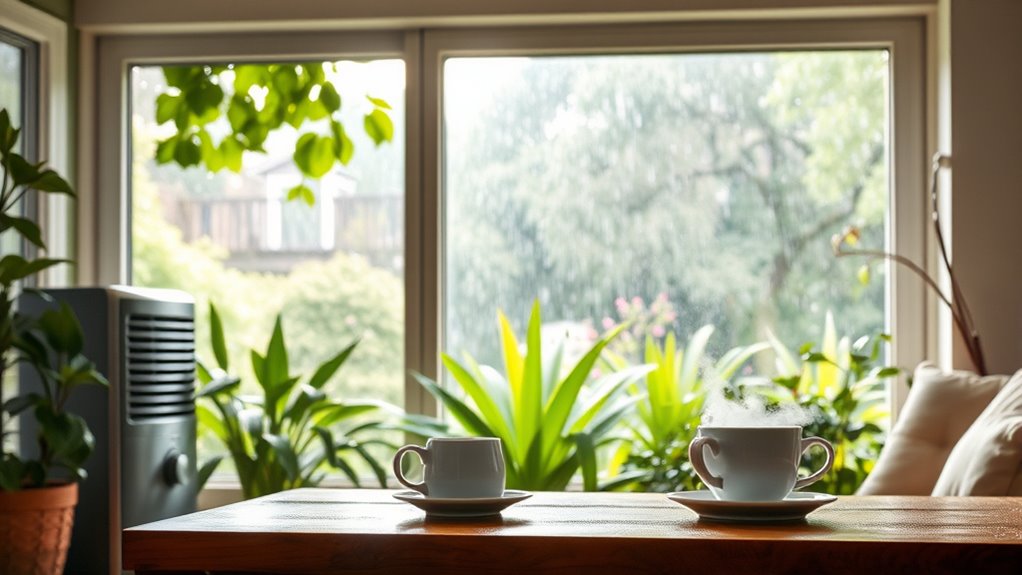During rainy spring days, you should monitor indoor humidity levels with a hygrometer and use a dehumidifier to keep moisture in check. Ventilate your home by opening windows when possible, and avoid overwatering indoor plants. Keep an eye out for musty odors or visible mold, and maintain good airflow to prevent fungal growth. Properly managing humidity now can help protect your home and belongings—if you continue, you’ll discover more tips to keep your environment comfortable.
Key Takeaways
- Use a dehumidifier with adjustable settings and humidity sensors to maintain optimal indoor moisture levels.
- Increase ventilation and air circulation to prevent mold growth and stale air during rainy days.
- Monitor indoor humidity with a hygrometer to ensure it stays within a healthy range (30-50%).
- Adjust watering schedules for indoor plants based on increased outdoor humidity to avoid overwatering.
- Regularly inspect for mold, dampness, and musty odors, and address issues promptly to protect your home.

Spring days can bring a surge in humidity that impacts your comfort and home environment. As the rain taps steadily against the windows, you might notice your indoor air feeling damp, heavy, or stale. This increase in moisture can cause discomfort and even lead to issues like mold growth or musty odors. Managing humidity becomes vital, especially if you’ve got indoor plants or sensitive belongings. To keep your space comfortable and healthy, you’ll need to pay attention to indoor plant care and consider the right dehumidifier selection. Proper humidity levels can also help prevent damage to furniture, electronics, and other personal items.
When it comes to indoor plants, high humidity can be both a blessing and a curse. Many houseplants thrive in moist conditions, but too much moisture can cause root rot or fungal diseases. You should monitor your plants closely during rainy spring days, adjusting watering schedules accordingly. If your plants seem to be suffering from excess moisture, improve air circulation around them and avoid overwatering. Proper indoor plant care involves balancing humidity levels, ensuring your plants get enough moisture without drowning their roots. Using a hygrometer can help you keep track of humidity around your plants, so you can make informed decisions. Additionally, grouping plants together can create a microclimate that maintains a consistent humidity level, but don’t forget to give them some space for air flow. Maintaining appropriate humidity is also crucial for preventing mold growth, which can thrive in damp environments.
Choosing the right dehumidifier is essential during rainy days when humidity can spike unexpectedly. Look for a dehumidifier with adjustable settings, so you can tailor its operation to your comfort level. A model with a built-in hygrometer or humidity sensor makes it easier to keep the indoor environment balanced. Consider the size of your space; a larger capacity unit will handle more moisture in bigger rooms, while smaller models suit bedrooms or offices. Portability might also matter if you want to move the dehumidifier between rooms. When selecting one, prioritize energy efficiency, as running a dehumidifier constantly can increase your energy bills. Also, opt for an easy-to-clean filter to maintain good air quality inside your home. Remember, a dehumidifier isn’t a one-size-fits-all solution. You’ll want to match its capacity to your space and humidity levels, especially during rainy spring days when moisture tends to linger.
Frequently Asked Questions
How Does Humidity Affect Indoor Air Quality During Spring?
High humidity during spring can lower your indoor air quality by promoting mold growth and dust mites. To combat this, you should improve indoor ventilation to remove excess moisture and guarantee fresh air circulation. Using air purification devices helps filter out allergens and pollutants that thrive in humid conditions. By maintaining proper humidity levels and enhancing ventilation, you create a healthier indoor environment for you and your family.
Can Humidity Levels Impact Allergy Symptoms in Spring?
Humidity levels can be like a double-edged sword, impacting your allergy symptoms during spring. When the air’s too humid, it fosters allergy triggers and pollen dispersion, making symptoms worse. On the other hand, low humidity can dry out your nasal passages, intensifying discomfort. Maintaining ideal humidity helps reduce pollen spread and keeps allergy symptoms in check, so you can breathe easier and enjoy the season more comfortably.
Are There Specific Plants That Help Control Indoor Humidity?
Yes, certain plants act as natural dehumidifiers and help control indoor humidity. Plants like Boston Ferns, English Ivy, and Peace Lilies absorb moisture from the air, reducing dampness. Combine these with indoor air purifiers to improve air quality further. These natural solutions work well during rainy spring days, keeping your home dry and comfortable while also adding aesthetic appeal. Remember to regularly care for your plants for ideal humidity control.
How Does Humidity Influence the Growth of Mold and Mildew?
Humidity levels directly impact mold prevention and mildew growth. When humidity rises above 60%, it creates an ideal environment for mold spores and mildew to thrive. You’ll notice increased risk in damp areas like bathrooms and basements. To prevent mold, keep indoor humidity below this threshold by using dehumidifiers and ensuring proper ventilation. Regularly check for moisture and dry any damp surfaces promptly to protect your home from mold and mildew issues.
What Are the Long-Term Effects of High Humidity on Home Structures?
High humidity acts like a slow, relentless rain inside your walls, weakening your home over time. It can cause wood to rot, paint to peel, and insulation to lose its integrity. Regular HVAC maintenance helps control moisture levels, preventing damage, while ensuring insulation remains effective. Ignoring this can turn your cozy sanctuary into a fragile structure, vulnerable to decay and costly repairs in the long run.
Conclusion
Don’t let the damp, humid days ruin your spring mood. With just a few simple strategies—like using dehumidifiers, proper ventilation, and moisture absorbers—you can keep your home comfortable and mold-free. You might think it’s a hassle, but these quick fixes are easy to implement and truly effective. Stay proactive, and you’ll enjoy a fresh, dry space all season long. Spring’s beauty shouldn’t be overshadowed by humidity—take control today!








